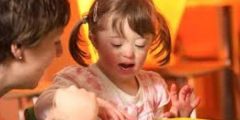Baby development in the sixth month
The first six months of a child’s life is a very important period in the child’s growth and development, as the child will develop very quickly after that, as the left side of the child’s brain will have begun to communicate with the right side of the brain, and thus the ability to coordinate the child’s body better. Since the child at this stage begins to respond to words, the mother at this age will be able to understand her child better and will begin to understand his feelings, whether he is sad or happy.
In general, the skills that a child acquires at this age stage, such as taking the first step in walking, smiling for the first time with the people around him, and waving his hand to express farewell, are all called signs of development. Children may reach prominent stages in how to play and in learning things and They acquire it from the people around them, talking to other people, the behaviors that children show to other people around them, and how to move from one place to another, whether by crawling or walking. It is worth noting that children’s development may occur at a speed that suits each child, so it is impossible Knowing when the child will learn or acquire a certain skill during his life. However, the signs of growth and development in the child may give a general idea of the changes expected to occur when the child grows up. It is worth noting that the first and basic task of the parents and the mother in particular is to pay attention to the child in all aspects in this regard. Age stage, in order to consult a doctor and talk to him if the child does not achieve the main signs of growth within his age, or if the parents believe that there may be a problem with their child’s growth.
Read also:The appearance of blood in the infant's stool
Signs of cognitive development
The signs of cognitive development in a six-month-old child are linked to the development of the child’s brain, in addition to his IQ and thinking prowess. Among the most important and prominent of these signs are the following:
- At this age, the child becomes more curious, and has a new sense of amazement and fascination towards the environment around him, in addition to trying to touch and carry things around him that arouse his curiosity.
- At this age, the child experiences the results of many actions and measures the reactions of the people around him to them.
- At this age, parents begin to notice the child’s response when talking to him, by making several vowel sounds and consonant sounds, such as: “ah,” “eh,” or “bah.” This is because the child’s comprehension of verbal communication is slow for him.
- The child makes efforts to imitate the sounds he hears around him, because the child's skills in interpreting sounds improve at this age. These sounds are often words and noises made by parents or caregivers around him, or the sounds of toys that the child owns.
- The child begins to remember the sound of his name well and begins to interpret it and show a response when called. Parents may make a lot of efforts to achieve this.
- Self-awareness improves in children at this age; Responding to a person’s name is the first step towards a child’s self-awareness, and this appears clear when the child shows his admiration for himself when seeing himself in the mirror. Children at this age love their thinking and are never bothered by seeing their image in the mirror, which may indicate improved abilities. Their brain recognition.
Read also:Baby development in the fifth month
Signs of physical development
Signs of physical development include both developmental signs related to the child’s physical development in addition to his overall motor abilities, including the following:
- Seeing colors well and going deeper into them: The child’s eyes are considered one of the most important signs of physical development in the first six months of his life, as his color vision improves at this age and he is then able to distinguish between two spectrums of colors, and therefore he likes to look at things high up. Contrast: He may also like colorful and bright story books. At this age, the child also has a heightened awareness of depth and distance around him, which helps him distinguish objects and distances accurately. For example, a child at this age may begin to stare intently at a ball rolling in front of him until it stops.
- Improved hand-eye coordination: Improved vision in the child leads to more precise functions in the hand. After six months, the child will be adept at extending his hand to pick up objects, even if it is while moving, as the child’s hand control will have developed enough to He is able to hold something and move it towards him after reaching the first six months and a little later. The child learns how to let go of something and understands that the thing has fallen from his hand. Once he picks something up, he examines it carefully and may also pass it from one hand to the other, and in a manner In general, a child at this age may tend to use only one hand a lot and then move to the other hand, so it will be difficult to determine whether the child is left-handed or right-handed at this age.
- Steady head control.
- Sit with a straight back when supported, in addition to turning well in both directions.
- Understand that things may be hiding behind each other.
- Start pushing the body into a crawling position at this age, and perhaps start crawling back and forth on the knees.
- Start standing with the help of others, and he may be able to jump and get up quickly.
- Disappearance of reflexes found in newborns.
Read also:Baby developments in the fourth month
Signs of social and emotional development
This development helps infants form social bonds with key people around them. Signs of social and emotional development during this age include the following:
- The child is able to read some of the expressions of the people around him. For example, he will smile when the person opposite him shows that he is happy, and he may appear worried if it seems to him that the person opposite him is tired.
- The child knows and understands that the people around him usually come to him when he feels the need for something, but without fully understanding that the person opposite them is a completely separate person from them.
- The child feels reassured and safe around him when the people around him understand his needs and try to meet these needs.
- The child feels happy when smiling and when interacting with other people around him other than his parents at this stage of life.
- The child feels happy and excited when the parents start conversations with him, and the child may express this happiness by kicking his legs or waving his arms.
- The child's social activity, recognizing and responding to familiar faces around him; The child is more active during this stage, but the child’s excessive excitement may cause him to cry.
- Startle when loud noises are made around him, and these loud sounds may cause the child to feel frightened and cry.
- Expressing different emotions including happiness, pleasure, sadness, resentment and anger.
- Pronunciation of consonants such as “ba”, “da”, and “ga”, and babble such as “bababa”.
- Recognize his name when called.
- Understands certain words because they are repeated often around him.
- Using his voice to attract the attention of those around him and express his feelings.
Baby sleeping in the sixth month
By the time they reach the sixth month of age, many children sleep during the night, taking a nap two to three times during the day. It should be noted that a child’s inability to sleep during the night does not necessarily mean that something is wrong; This may be due to the difference in the child’s development schedule or the difference in the child’s sleep needs from other children. It should be noted that there are many things that may interrupt the child’s sleep at night; Including a growth spurt, infection, or teething. The child may also begin to sleep a little better during the night once he begins eating solid foods. It should be noted that many children begin to roll over during this stage, which may cause anxiety for many parents. When it comes to sleep, fortunately, the risk of Sudden Infant Death Syndrome decreases significantly when the child reaches six months of age, and the current recommendations of the American Academy of Pediatrics include sleeping Children are on their backs, making sure that there is no need to readjust the child’s sleeping position if he rolls over during sleep. To reduce the risk of the child suffering from Sudden Infant Death Syndrome, parents can do the following:
- Stop wrapping the child in a swaddle, because it may pose a danger to the child if it becomes loose, as the child becomes more active at this age.
- Don't put anything soft or loose in bed, including blankets, quilts, pillows or stuffed animals.
- Do not use crib bumpers.
- Use sleeping bags instead of blankets during the colder months.
- Turn on a fan in the child's room.
- Keep the temperature cool and comfortable to prevent overheating.
Nutrition of the baby in the sixth month
The pediatrician recommends that the mother begin introducing solid foods to the child when he reaches six months of age, if she has not already started, as it is recommended to start with iron-fortified cereals mixed with breast milk or a specific milk formula, and when the child begins to adapt to solids, it is recommended to start Offering mashed fruits and vegetables one by one to the child, but you must wait for a few days each time the mother tries something new to ensure that the child is not allergic to it, and monitor any reactions that may occur in the child such as skin rash, diarrhea or vomiting, and if the child shows no His love for the new food offered by the mother, so the mother must wait for a few days and then try to offer it to him again. Children are fickle creatures and their tastes can change from one day to the next. According to the American Academy of Pediatrics, there is no Evidence that introducing foods such as eggs and fish after the sixth month of a child’s life may increase the risk of food allergies in the child, as the Academy recommends introducing allergenic foods early in most cases, and it is worth noting that parents should wait before offering honey to the child until he reaches puberty. At least one year of age, because honey can carry bacteria that may cause food poisoning in the child, and although products made from cow’s milk, such as yogurt or soft cheese, are good, it is worth not offering cow’s milk to the child until he reaches at least one year. .
Tips to improve baby development in the sixth month
In general, the development of the child begins long before his birth, as the development of the fetus’s nervous system begins from the first week of pregnancy, and its basic picture is completed by reaching the fourth week of pregnancy, and by the seventeenth week the fetus may begin to hear, so it is important to begin Reading, singing, and starting other activities for the child in order to help stimulate his growth at this age stage. Some methods that can be followed to enhance the child’s growth and care, which may help develop the child’s language and motor skills, can be mentioned as follows:
- Communication with the child: The most important thing that can be done to help a child develop his motor and language skills is to engage in human communication with him, and this includes holding the child, talking or singing with him, and doing any other things that can stimulate his hearing. It is also very important to stimulate his vision. The child. When the child is awake, you must make sure that the child is able to see the faces of those around him.
- Talk to the child: Including calling the child by his name or any other words so that the child feels that the call is directed directly to him.
- Turn off the TV: Since the child does not need television or computers during the first year of his life; These screens can hinder the child’s development, and it is worth noting that the child is able to develop language and other skills better through direct human interaction with him. This is because it needs direct feedback and comments from other people.
- Reading to the child: Reading to a child enhances the child’s ability to speak in addition to its role in developing his thinking, as the child will become immersed in the words and may imitate the sounds he hears. Parents can start with books that contain large pictures with bright colors, so that parents can describe what is happening on each page. Allows the child to point to common objects and name them.
- Playing with the child: It is possible to play with the child with many favorite games; Such as hiding something and encouraging the child to find it, or asking the child about one of his body parts and then pointing to this organ and mentioning its name within earshot of the child, and other games.
- Hugging the baby for enough time: This enhances balance. Gentle caresses and kissing the child can help the child feel safe and loved, and speaking quietly or singing to the child when carrying or shaking him.
- Play music for baby: Music can help the child feel calm, entertain and educate him, by singing to him or playing songs for him.
- Leave a private space for the child: Even children need their own space, and this may appear when the child turns away, closes his eyes, feels upset, or takes a break. It is worth getting to know the child’s unique personality, his temperament, and the things he likes or does not like, and the fact that responding to the child’s needs helps to continue building The child's trust in the parents.









